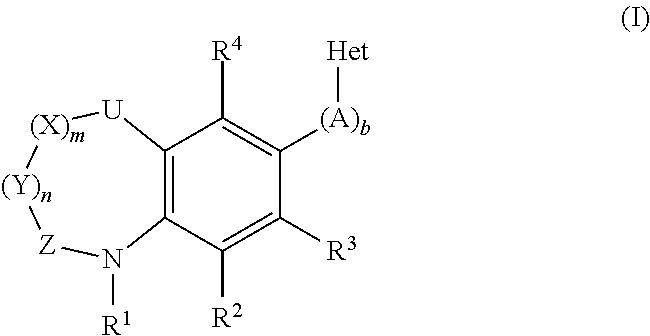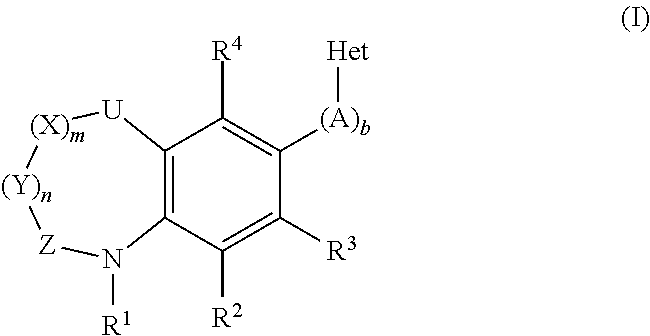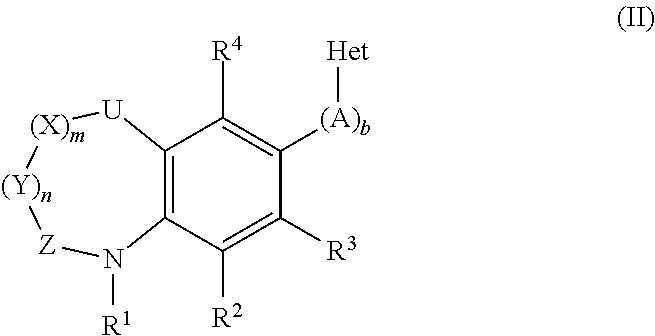6-pyridin-3-yl-3,4-dihydro-1h-quinolin-2-one derivatives and related compounds as inhibitors of the human aldosterone synthase CYP11B2
a technology of aldosterone synthase and derivatives, which is applied in the field of heteroaryl substituted derivatives of quinolinones and related compounds, can solve the problems of affecting the function, affecting the synthesis efficiency of spironolactone, so as to accelerate the degradation of some compounds
- Summary
- Abstract
- Description
- Claims
- Application Information
AI Technical Summary
Benefits of technology
Problems solved by technology
Method used
Image
Examples
synthesis example 1
6-Bromo-3,4-dihydro-1H-quinolin-2-one
[0269]To a solution of 3,4-dihydro-1H-quinolin-2-one (10.0 g, 67.9 mmol) in 100 ml dry DMF was added dropwise a solution of N-bromosuccinimide (12.7 g, 71.3 mmol) in 150 ml dry DMF at 0° C. The mixture was stirred at 0° C. for 2 h, then 400 ml water was added and the solution was extracted with ethyl acetate (3×150 ml). The organic phase was washed with water (2×200 ml), then dried over MgSO4 and evaporated, affording a yellow solid which was purified by washing with cold ether providing pure 6-bromo-3,4-dihydro-1H-quinolin-2-one (13.6 g, 60.3 mmol, 89%) as colorless needles.
synthesis example 2
6-Bromo-1-methyl-3,4-dihydro-1H-quinolin-2-one
[0270]To a solution of 6-bromo-3,4-dihydro-1H-quinolin-2-one (339 mg, 1.50 mmol) in 15 ml dry DMF was added potassium tert-butylate (336 mg, 3.0 mmol). After the mixture was stirred for 30 min at room temperature, a solution of methyl iodide (426 mg, 3.0 mmol) in 5 ml dry DMF was added. Following overnight stirring, the mixture was diluted with 100 ml 1 N HCl. Extraction with ethyl acetate (2×100 mL) followed by washing of the organic extracts with water and brine, drying over MgSO4 and removal of the solvent in vacuo gave a light yellow solid. Purification by flash chromatography (hexanes / ethyl acetate, 7 / 3, Rf=0.21) gave 6-bromo-1-methyl-3,4-dihydro-1H-quinolin-2-one (281 mg, 1.17 mmol, 78%) as colorless needles.
synthesis example 3
6-Bromo-1-ethyl-3,4-dihydro-1H-quinolin-2-one
[0271]To a solution of 6-bromo-3,4-dihydro-1H-quinolin-2-one (750 mg, 3.32 mmol) in 20 ml dry DMF was added potassium tert-butylate (804 mg, 6.64 mmol). After the mixture was stirred for 30 min at room temperature, a solution of ethyl bromide (724 mg, 6.64 mmol) in 10 ml dry DMF was added. Following overnight stirring, the mixture was diluted with 150 ml 1 N HCl. Extraction with ethyl acetate (2×100 mL) followed by washing of the organic extracts with water and brine, drying over MgSO4 and removal of the solvent in vacuo gave a light yellow solid. Purification by flash chromatography (hexanes / ethyl acetate, 1 / 1, Rf=0.52) gave 6-bromo-1-ethyl-3,4-dihydro-1H-quinolin-2-one (583 mg, 2.29 mmol, 59%) as a colorless solid.
PUM
| Property | Measurement | Unit |
|---|---|---|
| temperature | aaaaa | aaaaa |
| temperature | aaaaa | aaaaa |
| pH | aaaaa | aaaaa |
Abstract
Description
Claims
Application Information
 Login to View More
Login to View More - R&D
- Intellectual Property
- Life Sciences
- Materials
- Tech Scout
- Unparalleled Data Quality
- Higher Quality Content
- 60% Fewer Hallucinations
Browse by: Latest US Patents, China's latest patents, Technical Efficacy Thesaurus, Application Domain, Technology Topic, Popular Technical Reports.
© 2025 PatSnap. All rights reserved.Legal|Privacy policy|Modern Slavery Act Transparency Statement|Sitemap|About US| Contact US: help@patsnap.com



